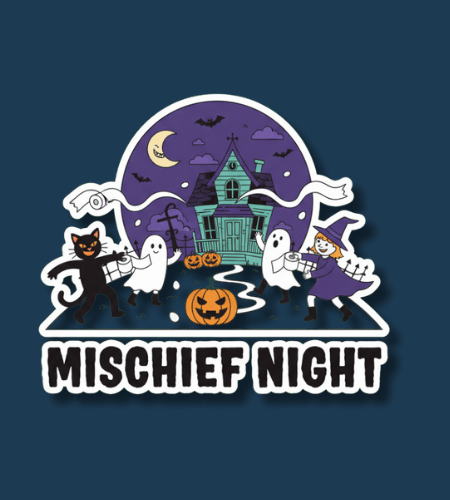Mischief Night is an informal observance—often taking place on October 30, the night before Halloween—when people, especially youth, engage in pranks, minor vandalism, or playful trouble‑making.
Table of Contents
History of Mischief Night
The term “Mischief Night” traces back at least to the late 18th century in Britain. For example, a reference from 1790 in Oxford describes a “Mischief Night” connected with the eve of May Day. Over time the tradition shifted: in parts of the UK the night before Bonfire Night (4 November) took on the mischief role, while in North America, the night before Halloween (often October 30) became the dominant date for recording pranks, toilet‑papering yards, egging houses, pulling doorbells, or other tricks.
Why is Mischief Night important/interesting?
Though not a formal holiday, Mischief Night is culturally interesting because it highlights the boundary between play and disorder, between tradition and mischief. It offers insight into how societies allow a “night of exceptions” where rules are loosened, norms are tested, and youth may claim a short‑lived space for chaos. At the same time, the night raises issues about responsibility, community, property, and how prank culture can cross into harm or damage.
It also reminds us of how traditions evolve: what began as mild jokes and community pranks can escalate in some places into serious vandalism or worse (for example, in some US cities under the related “Devil’s Night”). The night can thus act as a mirror of social tensions, youth expression, and community responses to mischief.
Here are some reflections on why the night stands out:
- It shows how ritualized mischief can become part of local tradition, even if informal.
- It raises the question of the line between harmless prank and harmful act, and how communities navigate that.
- It gives space to youth‑led social behavior—both creative and disruptive—and how that is perceived by adults and authorities.
- It highlights that even minor acts of rebellion or fun are tied into broader social norms: community, responsibility, ownership.
- It encourages reflection on how these “exception nights” reveal much about neighborhood culture, supervision, and risk.
How to Observe Mischief Night
Observing Mischief Night depends a lot on local norms, laws, and community spirit. If you live in an area where the night is celebrated loosely, you might join harmless pranks (toilet‑papering trees, ringing doorbells, leaving funny notes) within safe and respectful boundaries. If you’re in a community where mischief tends to escalate or cause damage, observing might mean staying safe, being aware, perhaps turning the tradition into something fun but compliant (e.g., a costume brunch or neighborhood prank contest with permission).
If you prefer a low‑key or positive twist, you could use the night to reflect on the theme of mischief: what playful rules do you want to bend? How do you express fun without harming others? Or you could organize a “reverse mischief”—small ”acts of kindness disguised as pranks (e.g., leaving anonymous thank‑you notes, doing good deeds with a funny wrapper).
Here are some ideas:
- Join or host a friendly neighborhood prank night with clear rules of “prank without damage” (e.g., washable chalk drawings, funny signs) and an after‑party or safe space.
- If you’re a parent or guardian, use the night to speak with teens about boundaries: what pranks are okay, what aren’t, how to respect others while having fun.
- Organize a “reverse mischief” event: instead of tricking people, prepare small surprises for neighbors (helping rake leaves, leaving baked goods, etc) and call it “Mischief for Good.”
- If you live in a place with a serious Mischief Night tradition where vandalism is a concern, you could volunteer for or join community patrols, or simply stay aware and safe.
- Document the night: take photos of the harmless pranks, collect stories of local tradition, talk to long‑time residents about how Mischief Night has changed in your area.
Mischief Night Dates Table
| Year | Date | Day |
|---|---|---|
| 2025 | October 30 | Thursday |
| 2026 | October 30 | Friday |
| 2027 | October 30 | Saturday |
| 2028 | October 30 | Monday |
| 2029 | October 30 | Tuesday |
Subscribe to our newsletter and never miss a holiday again!

